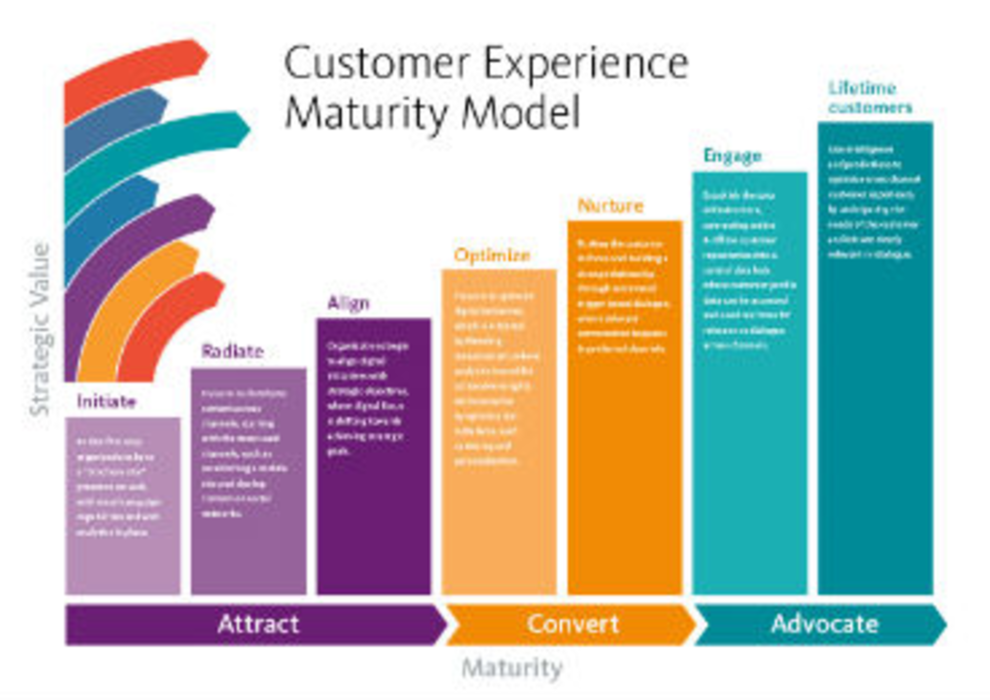“Putting customers at the center of your business is what it takes to create a competitive advantage.” This simple, yet bold, statement by Lars Birkholm Petersen launched a discussion around where most businesses are in terms of their customer experience maturity level.
During a presentation at Sitecore Symposium 2014, Petersen reviewed the marketing automation company’s Customer Experience Maturity Model (see above). Its stages are initiate, radiate, align (the “attract” phase of the customer lifecycle); optimze, nurture (the “convert” phase); engage, lifetime customers (the “advocate” phase). “We’ve found that 85.4% of companies are in first two stages,” said Petersen, global director, business optimization services, at Sitecore. “Strategic value increases as you move further along the model. If you’re in those first two stages, how do you get started?”
Ron Person, senior consultant, business optimization, for Sitecore, took the stage to answer Petersen’s question. To move ahead to stage three, “align,” connect corporate objectives to marketing objectives, Person advised. There are six steps to doing so: determining strategic themes (e.g., customer intimacy, top quality), setting strategic objectives (what’s needed to make the theme become a reality), defining marketing objectives (specifically to support the strategic objectives), setting digital goals, creating an engagement value scale, and then selecting key performance indicators. This process will help show the link between business objectives and customer actions.
“All marketing tactics, down to A/B testing, need to contribute toward reaching strategic objectives,” Person stated emphatically.
The fourth stage is “optimize,” which includes such activities as rules-based personalization, A/B and multivariate testing, and campaign attribution. Chris Nash, who joined the stage with Person, explained that optimization, such as in-the-moment personalization, is exceptionally powerful. “Use it in all phases of the customer lifecycle,” said Nash, senior consultant, business optimization, for Sitecore. “Use customer data [in real time] as it becomes available; use the data that makes the most sense to use for that personalization. Use different types of data in different combinations.” Doing so can be complex, he said, but its effectiveness is worth the effort.”
“Optimization is the low-hanging fruit of experience marketing,” Nash said. “Focus on the buyer journey.”
Get connected
After the presentation Petersen, Person, and Nash met with several anaylists and journalists (myself included), to dive deeper into the topic of customer experience maturity, which is a central theme of their new book Connect: How to use data and experience marketing to create lifetime customers.
Considering the complexity of the customer experience, and of marketing, I asked: Are companies at multiple stages of customer experience maturity with different aspects of their marketing? For example, is the email customer experience more mature than in other channels? If so, how can they better connect those stages?
“Companies are being forced by customers to create a connected experience,” Nash said. “It puts pressure on organizations to think about the quality of the overall customer experience. Email, for example, is an ‘advanced’ silo, but it’s often a disconnected experience from other channels.” Nash explained that this type of disparity creates “moments of disconnected frustration” for customers.
Eliminating the disconnect and creating a consistent customer experience is all about people, process, and technology, Peterson noted. Marketers need to focus on the customer across channels in a connected way; they should collect and use data create relevant, contextualize experiences. “This goes back to marketers needing to ensure that they align the customer experience with strategic objectives to get business value,” he said, referring to the Customer Experience Maturity Model. “Once they’re doing that, they can optimize and nurture. Then can moved to engage and lifetime customers.” But tread purposefully: “It takes time, maybe years to move up the maturity model, espcially in a big organization,” Petersen said.
The journey, however, is more necessary than ever before.
“Businesses that excel at customer experience,” Nash said, “make it so other companies need to do the same.”








